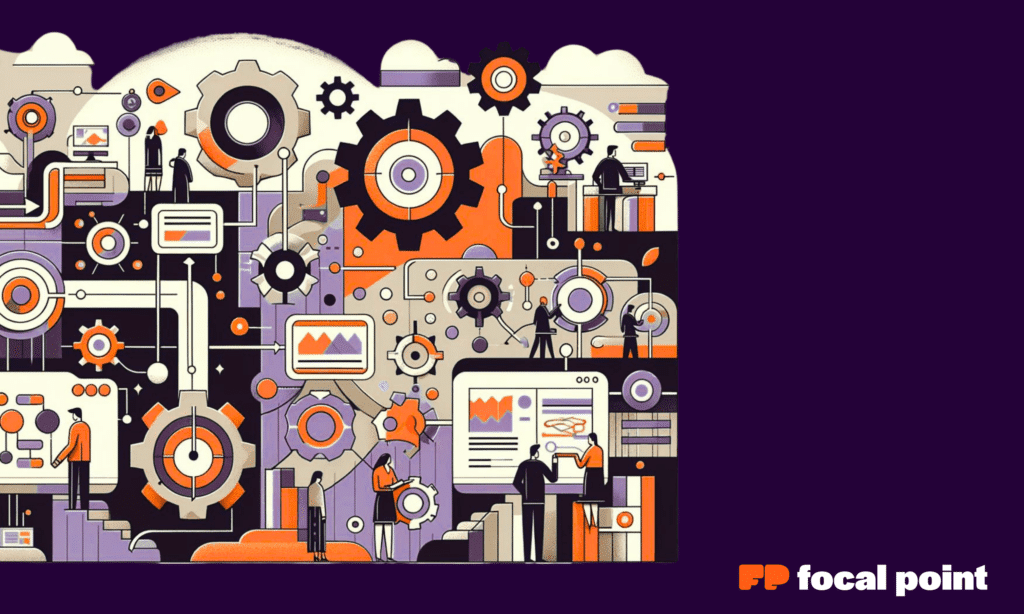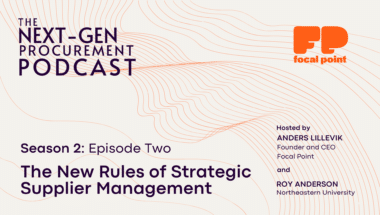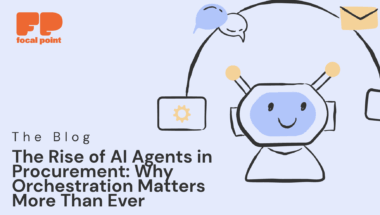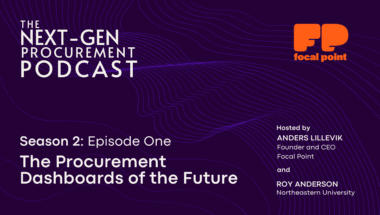Are you still using manual and paper-based methods like Excel for procurement? It’s time for a change. Embrace the potential of procurement automation to transform how you handle purchasing tasks. Businesses worldwide are adopting procurement process automation to boost efficiency, accuracy, and speed in procurement activities.
What if you could quickly and easily set up automation and conditional logic for intake self-service and smart triage?
With automation tools and platforms, you can eliminate the old, tedious manual procurement processes that are prone to errors. Automated systems handle everything from order creation to management, replacing the need for paper. This change not only saves time and reduces mistakes but also lets your team focus on tasks that add more value.
See how procurement automation can significantly alter how your company operates. Enjoy benefits like better efficiency, saving costs, improved visibility, and stronger ties with suppliers through automating procurement. Discover the power of top procurement automation software and which tasks are best to automate.
Get ready for the future with procurement process automation and surge ahead of your competition.
Be proactive and unleash the true capabilities of your procurement function by leveraging automation.
Key Takeaways
- Procurement automation modernizes purchasing tasks, increasing efficiency and precision
- Automatic systems swap manual, paper strategies with digital solutions
- Procurement process automation allows teams to concentrate on strategic goals
- Automation technologies and platforms lead to cost reductions and better insights
Choosing procurement automation stands out in today’s competitive business realm In our advanced, fast-paced business world, procurement automation has become essential for those seeking to enhance their processes and stay ahead. It involves using cutting-edge technologies to automate crucial tasks. This approach leads to greater efficiency, transparency, and stronger relationships with one’s suppliers. Let’s dive into some of the key procurement processes that can significantly improve by being automated. Supplier Management Automating supplier management simplifies operations and decreases errors. By utilizing a procurement automation tool such as Focal Points Procurement Platform, you can bring all your supplier data together, track their performance, and manage your relationships with them. This centralization enhances efficiency and transparency and reduces risks. In the end, it leads to better procurement results and success for your organization. Invoice Approval When you automate the approval of invoices, you speed up payment times and cut down on errors. In an automated system, invoices are checked against purchase orders and receipts without manual intervention.
This ensures payments happen on time and boosts your cash flow. It also gives you better oversight of your financial dealings, which helps prevent fraud and mistakes. Contract Management Procurement processes benefit greatly from automating contract management. Doing so cuts down on the manual work involved in creating, negotiating, and tracking supplier agreements. Such an automation platform helps you stick to procurement policies while making contracts more visible. It also eases the process of renewing or changing agreements, which promotes healthy supplier relations and reduces risks. And by storing all contracts in the cloud, they’re both secure and easy to find. Purchase Requests Streamlining purchase requests in your procurement process means less lag time and timely procurement of needed items. With an automated system, employees can submit requests that then go through an already-set-up approval system.
This approach makes your processes more efficient, transparent, and compliant. It helps your organization watch its spending better, which ultimately leads to operational excellence. The systems can also decide on their own if a certain order meets the set standards for approval. Purchase Orders Automating purchase orders lessens the work involved in handling them manually. A procurement automation system, in this case, generates purchase orders automatically as per the approved requests. This ensures they are precise and in line. The whole process minimizes mistakes and delays, which betters the overall function of procurement. This kind of workflow automation brings real-time benefits. Today, large organizations and procurement teams use tools such as Focal Point to control their spend and supplier relationships more efficiently. It helps cut costs and run a smoother procurement operation.
| Procurement Process | Benefits of Automation |
|---|---|
| Supplier Management | Streamlined operations, reduced errors, enhanced transparency |
| Invoice Approval | Accelerated payment cycles, improved cash flow management, minimized errors |
| Contract Management | Ensured compliance, enhanced contract visibility, optimized supplier relationships |
| Purchase Requests | Reduced delays, improved efficiency, enhanced transparency and compliance |
| Purchase Orders | Streamlined accounts payable, reduced errors, improved efficiency and cost savings |
Automating these core procurement processes unlocks the full power of procurement automation. It allows for gains in efficiency, cost savings, and strategic value. From this perspective, implementing procurement automation is more of a necessity than a choice for those wanting to stay competitive in the business world.
The Importance of Procurement Automation in Modern Business
Today, in the fast-moving business world, efficient procurement is key. Large companies know how essential it is to have fast procurement, along with smart sourcing and solid supplier relationships. The old ways of procurement, slow and error-prone, sometimes cost more. This is where procurement automation changes the game for companies today.
Automation in procurement makes the whole process smoother, from asking for something to paying. With cutting-edge software and tools, companies can get rid of manual work and errors. They can also speed up how they work. Procurement systems bring all the info about suppliers, deals, and buys to one place. This makes it easier to share info and keeps everything flowing.
One big plus of using automation is cutting down on costs. Automation means less human work, paperwork, and mistakes, which can save a lot of money. What’s more, it lets companies use info to find better deals and save money when buying from suppliers.
- Smarter procurement
- Faster and better work
- Less money spent
- Better management of suppliers
- More accurate and clear data
With automation, procurement professionals can now focus on the work that matters most. They can spend time getting along with suppliers and making deals, which adds a lot of value. This way, companies can get closer to their suppliers, be sure they follow the rules, and avoid problems in the supply chain.
Getting fresh data and useful stats quickly is another plus of automation. Systems that do things automatically keep track of every step in the process. This gives a clear look at costs, how suppliers are doing, and if deals are working as agreed. This insight helps companies make changes for the better and run their procurement smarter and more cost-effectively.
In the end, automation is vital for business today. Using the right tools can make getting things easier and cheaper, while also making companies more successful. As the business world changes, those using automation will likely do best, being ready to face new challenges, be creative, and find lasting success.
Understanding Procurement Automation
Procurement automation is a pivotal technology that is reshaping how businesses handle their purchasing tasks. It integrates avant-garde tools and solutions to streamline workflows, lower manual intervention, and enhance buying processes. This segment explores the definition of procurement automation and the pivotal technologies driving this innovation.
Definition of Procurement Automation
Procurement automation is using sophisticated technology to automate procurement processes. It implements software and platforms to digitize and simplify tasks, diminishing manual needs.
Organizations improve efficiency and reduce costs by automating key duties, such as choosing suppliers or handling invoices.
Procurement automation covers a broad range of activities, from data entry to contract management. It offers an all-encompassing approach to optimizing purchasing from start to finish.
Automation reduces the time and effort spent on procurement duties, allowing for a focus on strategic growth.
Key Technologies Used in Procurement Automation
For procurement automation, firms depend on an array of sophisticated tech. These work in unison to build systems that manage complex tasks effectively. The main technologies for automation include:
- Robotic Process Automation (RPA): RPA deploys software robots to manage repetitive, rules-based tasks. In procurement, it accelerates data management and order processing, bolstering efficiency while reducing errors.
- Artificial Intelligence (AI): AI helps systems understand data and make intelligent choices at record speed like machine learning and natural language processing. Procurement is key in assessing supplier risks and forecasting demand, which is critical for strategic planning.
- Machine Learning (ML): ML lets procurement systems improve by using historical data. It aids in choosing suppliers and predicting demand by recognizing patterns from former procurement cycles.
- Natural Language Processing (NLP): NLP enhances buyer-supplier communication by understanding and interpreting human language. It’s used in automating contract checks, supplier talks, and supporting through chatbots, making procurement more efficient.
Combined with Focal Point procurement software, these technologies are the core of procurement automation. They help organizations reshape their acquisition processes, cut costs, and outperform competitors.
| Technology | Application in Procurement Automation |
|---|---|
| Robotic Process Automation (RPA) | Automates repetitive tasks such as data entry, invoice processing, and purchase order creation |
| Artificial Intelligence (AI) | Enables intelligent decision-making, supplier risk assessment, spend analysis, and demand forecasting |
| Machine Learning (ML) | Optimizes supplier selection, contract negotiation, and demand prediction based on historical data |
| Natural Language Processing (NLP) | Facilitates seamless communication, automated contract review, and chatbot-based support |
5 Reasons to Automate Your Procurement Process
Procurement automation brings numerous transformative benefits to your organization. It relies on cutting-edge technologies and simplifies workflows, aiding in achieving efficiency, saving costs, and making more strategic decisions.
Let’s delve into how procurement automation could enhance your business.
Improved Efficiency and Time Savings For Your Procurement Team
One key advantage of procurement automation is boosting efficiency and saving time. This is achieved by automating manual tasks and eradicating monotonous activities. Consequently, your team can dedicate their time to managing supplier relationships and optimizing costs.
Integration in procurement automation extends from creating requisitions to supplier handpicking, order approval, and invoicing. All steps move fluently and quickly, easing time constraints on your team.
This framework ensures a lean and systematic procurement procedure, saving time and enhancing productivity.
Enhanced Visibility and Transparency
Procurement automation fundamentally enhances visibility and transparency in all procurement phases. It offers real-time tracking and monitoring to provide complete oversight. Such breadth of vision helps spot bottlenecks, track supplier performance, and enforce compliance with policies and regulations.
The system provides instant access to data and the ability to produce detailed reports. These tools offer valuable insights that help in making well-grounded decisions. They also aid in refining procurement strategies and reducing risks. This level of insight assures the accuracy and dependability of your procurement data, thus enhancing accountability and transparency within your organization.
Cost Reduction and Optimized Spending
Procurement automation significantly cuts costs and enhances spending strategies. By simplifying procurement workflow and leveraging data analysis, you can spot saving opportunities and make smart purchasing choices. This entire process also facilitates spending consolidation, better supplier negotiation, and cashing in on early payment perks.
This management process also improves inventory management, decreasing overstock and stockouts. By accurately forecasting demand and automating restocking, you’ll maintain ideal inventory levels. This effort minimizes storage expenses and prevents unnecessary spend. With automated procurement, you gain better control over your budget, spend, and resource allocation, leading to significant savings for your company.
Strengthened Supplier Relationships
Procurement automation is also vital in enhancing supplier relationships and streamlining the supply chain. Automating communication and collaboration enhances openness and efficiency in partnerships.
Systems that automate information sharing and updates enable efficient issue resolution, boosting supplier satisfaction.
Automated Procurement tasks simplify onboarding, ensure contract compliance, and track vendor performance. This approach streamlines supplier management, distinguishes top suppliers, resolves issues swiftly, and cultivates long-lasting, beneficial relationships.
Procurement software and automation can enhance your communication with suppliers, work more efficiently, and extract greater value from partnerships.
Data-Driven Insights for Strategic Decision Making
Procurement automation offers a treasure trove of data and analysis crucial for strategic decision-making.
By analyzing procurement data, you acquire insights into spending habits, supplier effectiveness, purchasing trends, and market variations. These insights help make informed decisions, improve procurement tactics, and adjust to market shifts.
Procurement software gives you access to dashboards and reports that offer a holistic view of your procurement operations. These insights pinpoint areas for growth, enable you to measure against industry benchmarks, and support decision-making that aligns with your objectives. By utilizing analytics, you can continually enhance your procurement, iron out inefficiencies, and ensure the ongoing success of your firm.
With Focal Point, always-accurate live data is at the ready to support procurement decisions and long-term strategy.
Procurement Process Automation: Transforming the Procurement Landscape
Procurement is dramatically changing as companies increasingly adopt automation. This shift is reshaping how B2B businesses approach efficiency and sourcing strategies. It brings forth a range of tools designed to simplify operations, decrease risks, and enhance relationships with vendors. Automation allows organizations to cut costs and boost overall effectiveness sharply.
Procurement automation is a comprehensive shift, not solely tech updates. It reimagines procurement processes for resilience and flexibility. This overhaul enables firms to manage suppliers better, smooth out processes, and base decisions on data. With the aid of procurement solutions such as the Focal Point Platform, unnecessary manual work is phased out, errors are minimized, and team cooperation is more effective.
The prime boon of automated procurement is the insight it provides through analytics and reports. Real-time details on spending, supplier performance, and contract adherence can lead to smarter strategies. This insight allows for pinpointing areas for enhancement and the making of business-savvy decisions. Thus, companies achieve savings, strengthen ties with suppliers, and enhance their overall operation.
Furthermore, these platforms easily join forces with current systems like ERP and accounting software. This connection ensures a seamless data flow, removes data partitions, and offers a comprehensive view of procurement procedures.
The whole procurement cycle, from requesting items to processing invoices, is automated. This approach leads to efficiency and a more transparent process.
As procurement’s function changes, automation’s necessity becomes clearer. Today, procurement teams need to be mindful of spending and stick to compliance rules. Procurement automation aids them by enabling smart choices, rule enforcement, and spending control.
Key Features of Top Procurement Automation Software
Searching for the best procurement automation software involves picking options that can boost your purchase protocol. These attributes aim to simplify tasks, enhance productivity, and offer insights for wiser choices. We’ll explore the three prime features that distinguish leading procurement automation solutions.
Seamless Integration with Existing ERP Systems
A pivotal aspect of premium procurement automation software is its flawless ERP system integration ability. This synchrony enables a seamless transfer of data from procurement to accounting, eliminating manual inputs and diminishing error risks. Integration maintains uniformity and compliance throughout the procurement path.
This effective integration elevates the value of your automation investment, aligning your purchasing system with broader business goals and compliance directives. Opt for a tool with strong integration features for a seamless deployment and ongoing prosperity.
Real-Time Data Analytics for Smarter Purchasing Decisions
Real-time analytics stand out as a vital feature in leading procurement automation solutions. This capability empowers professionals with instant insights on crucial aspects such as spending and supplier performance. By relying on real-time data, you can sharpen your purchasing acumen and enhance planning.
Today’s analytics allow for trend spotting, better demand predictions, and smarter supplier negotiations. Leveraging these insights improves purchase planning and optimizes inventory, ensuring product availability is timely and lean. By setting up analytics in your procurement system, you’re poised to excel in strategic sourcing, leading to substantial savings for your enterprise.
Streamlined Approval Processes with E-Signature Capabilities
Top-tier procurement platforms like Focal Point streamline approval with e-signature support. Implementing e-signatures in procurement smooths the process, enhancing efficiency and adherence to regulations. They offer fast, location-independent approvals, sidelining archaic paper trails.
This feature is instrumental in hastening approvals, avoiding manual delay, and staying abreast of digital trends. Embracing cutting-edge e-signature tech improves your approval cycle, elevating efficiency across your procurement domain.
| Feature | Benefit |
|---|---|
| ERP Integration | Ensures data consistency and compliance |
| Real-Time Analytics | Enables informed purchasing decisions and optimization |
| E-Signature Capabilities | Streamlines approval processes and ensures compliance |
Making the most of procurement automation software means valuing these features. With a platform that harmonizes with ERP, offers real-time insights, and supports e-signatures, you can elevate your procurement process. This strategic choice will propel your business’s procurement journey towards ongoing success.
Real-World Success Stories: Procurement Automation in Action
Procurement automation significantly reshapes how businesses operate, across many sectors. A standout example is a top retail firm that applied automation to enhance its operations. This move was key to boosting efficiency.
This retail leader adopted a powerful procurement automation system. It automated tasks like creating purchase orders, handling invoices, and managing suppliers. As a result, the workload of its procurement team eased. They could dive into strategic tasks and add value elsewhere.
Enhanced efficiency was just one perk. This makeover also cut costs. Errors from manual work were slashed, and spending became smarter. Plus, the system’s accuracy enabled the firm to base decisions on solid data. This led to better negotiation outcomes and chances to save costs.
Moreover, the automation system offered on-the-spot insights. It covered areas such as spending trends, how suppliers were performing, and if contracts were being followed. This information became their map for improvements. They could enhance how they procured, boost relationships with suppliers, and ensure compliance.
| Key Benefits | Impact |
|---|---|
| Improved Efficiency | Streamlined operations and reduced workload for procurement team |
| Cost Reduction | Eliminated manual errors and optimized spending |
| Data Accuracy | Empowered data-driven decision making |
| Spend Analytics | Real-time insights into spending patterns and trends |
| Supplier Performance | Enhanced visibility into supplier metrics and performance |
| Contract Compliance | Ensured adherence to contractual terms and obligations |
This success story underscores the game-changing role of procurement automation. The retail firm not only enhanced day-to-day operations but also primed itself for enduring success in a cutthroat market.
As the adoption of procurement automation grows, its impact becomes clearer. This tech will increasingly define the future of procurement. Those who embrace it will be in a strong position to tackle today’s business challenges. They can gain a leading edge within their sectors.
Overcoming Challenges in Adopting Procurement Automation
Procurement automation presents a significant opportunity for organizations but comes with its own hurdles. It’s vital to foresee and meet these obstacles head-on for a successful transition. Addressing challenges upfront unlocks automation’s potential, enhancing your procurement processes dramatically.
Addressing Complexity and Integration Concerns
Dealing with the complexity of current systems and processes represents a key challenge in automation. Successful integration relies on careful planning and execution, ensuring a seamless fit. A detailed assessment and a robust integration plan are indispensable. Working closely with seasoned procurement software vendors eases the integration path, minimizing operational disruptions.
Managing Change and Employee Resistance
Change management and overcoming employee reluctance are critical hurdles in automation adoption. Procurement teams may resist shifting from traditional to automated processes. It’s essential to focus on communication and training, highlighting automation’s benefits for their daily work. Foster an environment of learning and skill development to navigate change effectively and ensure the new system’s broad acceptance.
Scaling Implementation Across the Organization
Expanding automation across departments can be challenging logistically. This endeavor demands clear coordination and proper resource management. A phased implementation, beginning with critical processes, aids in effective resource use. This strategy lessens operational disruptions, ensuring a smooth and efficient automation deployment across the organization.
Tackling challenges proactively and strategically is key to successful automation adoption. Automation not only streamlines procurement but also offers crucial cost savings. By embracing this technology, companies can secure a competitive advantage in the digital landscape.
Choosing the Right Procurement Automation Vendor
Embarking on the journey to streamline procurement through automation is a challenge. It’s crucial to choose the right procurement automation vendor. This decision greatly affects the success of your initiative. In a market filled with various procurement software solutions, all with distinct features and capabilities, it’s vital to understand your organization’s needs clearly.
When assessing vendors, their integration capabilities are essential. The chosen automation tool must blend smoothly with your ERP systems and business applications. This ensures a seamless flow of data for improved operational efficiency. Seek vendors with a track record of successful integrations and references from similar industry clients.
Scalability is also key in vendor selection. Your automation solution should grow as your organization does. Check the vendor’s capacity to handle more transactions, users, and complexity without performance issues. A scalable automation platform secures your procurement automation investment over time.
For a successful procurement automation system, access to dependable vendor support is vital. Assess vendors on the support they offer, including response times and the expertise of their support team. A vendor that offers thorough training, ongoing technical aid, and readily solves problems prevents downtime and eases the shift to automation.
| Vendor A | Vendor B | Vendor C |
|---|---|---|
| Robust integration with major ERP systems | Limited integration options | Customizable API for seamless integration |
| Scalable architecture for enterprise-level deployment | Suitable for small to medium-sized businesses | Modular design for easy scaling |
| 24/7 dedicated support with SLA guarantees | Standard support during business hours | Tiered support plans with priority response |
While comparing vendors, consider making an evaluation matrix. This should cover all significant criteria for your organization, such as:
- Functionality and features of the procurement software
- User-friendliness and ease of adoption
- Reporting and analytics capabilities
- Security and compliance measures
- Total cost of ownership, including implementation and ongoing maintenance
By meticulously evaluating each vendor based on these criteria, you can choose wisely. This decision should reflect your organization’s objectives and lead to a successful business process automation. Remember, the right procurement automation vendor is not just about the technology. They should be a strategic partner, enhancing your procurement processes and delivering lasting value to your organization.
The Future of Procurement: Emerging Trends and Innovations
Procurement automation is evolving, redefining the landscape with each step. It brings forth trends and innovations, promising higher efficiency, savings, and strategic value. Artificial intelligence (AI) and machine learning (ML) are becoming vital, empowering smarter, predictive decisions. They allow procurement software to sift through massive data, spotting patterns and offering insights to enhance processes and manage suppliers better.
Blockchain emerges as a key player, offering secure, transparent, and unchangeable transactions. It has the power to change how we handle suppliers, boost traceability, and build trust in the supply chain. Organizations using blockchain for procurement benefit from smoother contract handling, assured compliance, and reduced risks such as fraud or shady deals.
The Internet of Things (IoT) is set to make its mark in procurement’s future. It allows the live tracking and monitoring of products using connected devices. This approach optimizes inventory, cuts down on waste, and makes the supply chain more efficient. With IoT integrated procurement systems, companies stand to gain deep insight into their supply chain, making quick, informed decisions and reacting promptly to potential issues.
| Emerging Trend | Key Benefits |
|---|---|
| Artificial Intelligence and Machine Learning | Intelligent decision-making, predictive analytics, improved efficiency |
| Blockchain Technology | Secure transactions, enhanced transparency, improved supplier management |
| Internet of Things (IoT) | Real-time tracking, optimized inventory management, reduced waste |
These trends and innovations in procurement are set to redefine operations. Companies leading this charge stand to gain significantly. By adopting advanced technology and integrating it into their processes, they can enhance efficiency, cut down on costs, and maintain a leading edge in a competitive world.
Embracing Procurement Automation for Competitive Advantage
Today, staying ahead in the business world means embracing procurement automation. Companies can gain a vital edge by automating their purchasing processes. This approach delivers numerous benefits, including enhanced efficiency, lower costs, and improved relationships with suppliers. Automation lets you cut down on manual work, reduce errors, and base decisions on solid data. The outcome is smoother operations and enhanced profits.

The true power of procurement automation lies in its efficiency boost. This method speeds up everything from making purchase requests to approving invoices. The task may have required a lot of time and energy, yet with automation, this burden lessens. Your team can tackle more meaningful projects, providing real value to your business, without the hassle of manual tasks.
Financial gains are another reason to pursue procurement automation. Reduction of costs in the procurement pathway is a key result. This process shortens the time taken and the possibility of mistakes in manual operations, reducing the chance of exceeding budgets. Through automation, you can spot opportunities to save money by analyzing data, like choosing the best suppliers or negotiating better prices. This ultimately improves your economic outcomes.
There’s also a strategic merit to be won with respect to procurement. Automation helps manage suppliers more effectively through performance tracking, compliance checks, and risk assessments. This knowledge empowers savvy choice-making in supplier selection, negotiation, and relationship management. Such a strategy not only secures timely delivery of products and services but also bolsters your position against rivals.
- Improved efficiency and productivity
- Reduced costs and optimized spending
- Enhanced visibility and control over procurement activities
- Strengthened supplier relationships and strategic sourcing
- Increased agility and adaptability to changing market conditions
| Traditional Procurement | Automated Procurement |
|---|---|
| Manual processes and paperwork | Streamlined digital workflows |
| Time-consuming and error-prone | Efficient and accurate |
| Limited visibility and control | Real-time data and analytics |
| Reactive supplier management | Proactive supplier collaboration |
Early adoption of a procurement platform such as Focal Points offers a competitive advantage as the procurement arena shifts. It propels your procurement department to become a key driver of business success.
This will lead to more savings, greater efficiency, and a stronger competitive stance. Securing the right automation tools will set your organization on a trajectory for growth and triumph over future market hurdles.
Conclusion
Unlocking procurement automation’s full potential requires partnering with a trusted vendor who understands your organization’s unique needs and can provide a tailored solution. Focal Point empowers procurement teams to centralize processes, automate workflows, and integrate data seamlessly with existing systems, ensuring maximum ROI.
Ready to experience the benefits of procurement automation firsthand? Book a demo with Focal Point today and discover how our platform can help you streamline your procurement processes, drive cost savings, and gain a competitive edge in today’s digital landscape.



